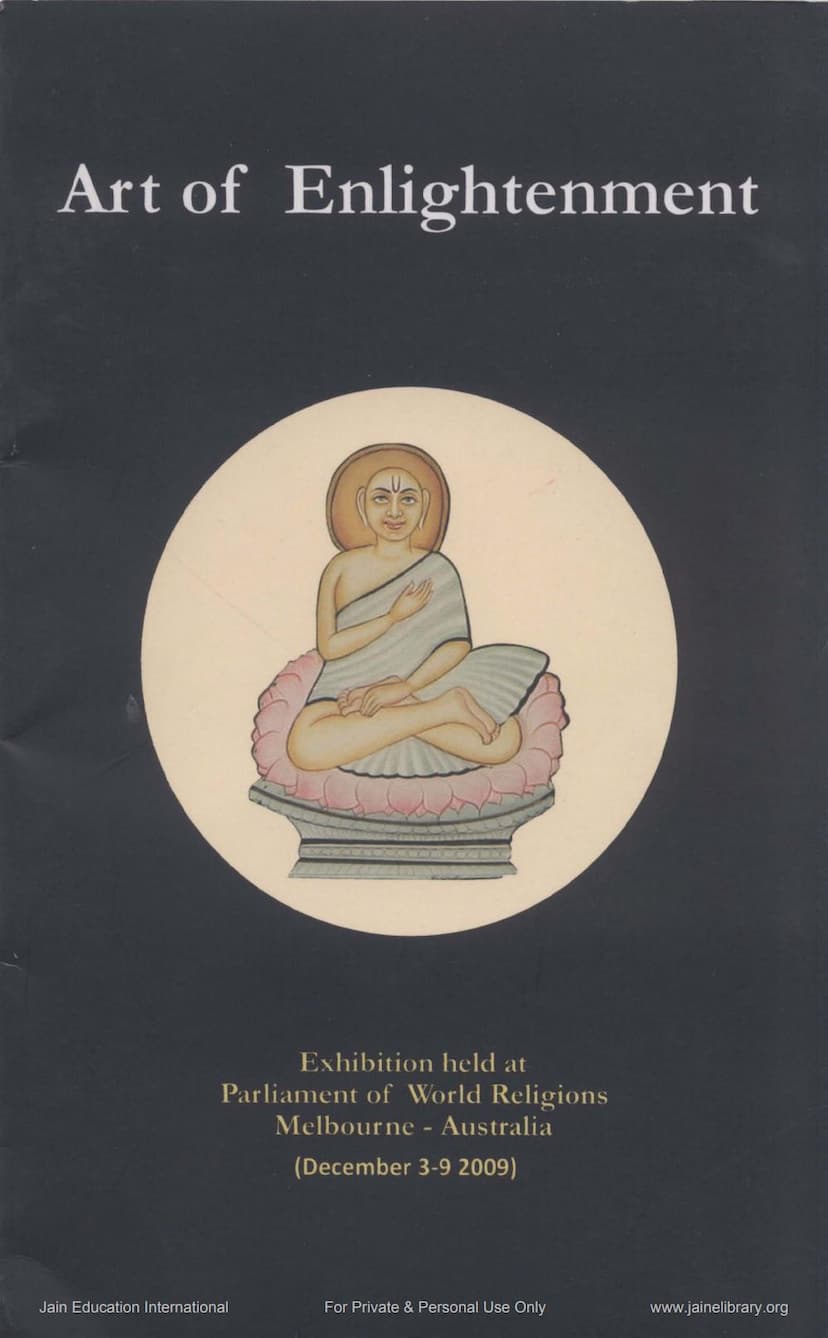Art Of Enlightenment
Added to library: September 1, 2025

Summary
This document is a catalog from an exhibition titled "Art of Enlightenment" by Kalpana Desai, held at the Parliament of World Religions in Melbourne, Australia, from December 3-9, 2009. The exhibition featured artworks derived from original Jain miniature paintings, specially commissioned for the event. It was sponsored by the Ratna Nidhi Charitable Trust, Mumbai.
The catalog serves as an introduction to Jainism through its rich artistic imagery. Key aspects of Jainism highlighted include:
- The Tirthankaras: Jainism is founded on the teachings of 24 Tirthankaras, who are seen as enlightened human beings who guide others across the cycle of life and death. Lord Mahavira, the 24th Tirthankara, is particularly emphasized.
- Core Principles: Jainism is characterized by its emphasis on non-violence (Ahimsa) in daily life (exemplified by vegetarianism and animal welfare) and the belief that every viewpoint holds relative truth, promoting religious tolerance.
- Artistic Expression: Jain art, including intricately carved temples, sculptures, and diverse paintings, has been a significant tool for spiritual guidance. Monks actively participated in creating and explaining art to illustrate Jain precepts.
- Key Life Events of Jinas: The catalog illustrates the five paramount events in the life of a Jina: conception, birth, lustration (ablution), renunciation (diksha), enlightenment, and final liberation. These are depicted through traditional miniature paintings.
- Iconography and Symbolism:
- Twenty-four Tirthankara Pata: A painting showing all 24 Tirthankaras, identified by their symbols and colors, around the founder, Rishabhadeva. It also depicts his principal disciple, Gautama Ganadhara, and the guru's footprints.
- Birth and Ablution of a Jina: Paintings showing auspicious dreams of the mother, prophecies, the birth, and the celestial lustration ceremony on Mount Meru.
- Renunciation and Liberation of Mahavira: Depictions of Mahavira's Great Departure, penances, and his preaching after attaining omniscience.
- Samavasarana: The celestial congregation hall established by Indra after a Tirthankara attains omniscience, where all beings assemble to hear divine preachings. The structure is described as having concentric walls and a central arrangement for the Jina.
- Neminatha's Renunciation: The story of the 22nd Tirthankara turning back from his wedding procession due to the impending slaughter of animals for the feast, highlighting the principle of Ahimsa.
- Cosmology and Philosophy:
- You and the Universe: Explains Jain cosmology, depicting the cyclical movement of the soul through different regions of the universe based on karma. It emphasizes the role of right knowledge, faith, and conduct in achieving liberation and reaching the Siddhashila (seat of liberated souls).
- Lokapurusha: The cosmic being representing the three worlds (upper, middle, and lower) and their inhabitants. The middle world, where humans reside, is the only place for liberation.
- Adhidvipa and Jambudvipa: Detailed descriptions and illustrations of the central parts of the Jain universe, where humans live, practice austerities, and where Tirthankaras are born and preach.
- Leshya (Karmic Colour): Explains how mental states, represented by colors, influence karma and liberation, using a parable of six men interacting with a tree.
- Gyana Bazi (Game of Snakes and Ladders): A traditional Jain game that illustrates the path to enlightenment, with ladders representing virtues and snakes representing vices, ultimately leading to the Siddhashila.
- Worship, Prayer, and Meditation: Discusses practices like worship of Tirthankaras, study of scriptures, visiting pilgrimage sites, reciting mantras and sutras, and meditating on yantras. The importance of a living guru is also highlighted.
- Specific Deities and Pilgrimage Sites:
- Chandraprabha in Meditation: An example of individual Jina worship.
- Shree Sammet Shikhara Tirtha: A significant pilgrimage site where many Tirthankaras attained liberation.
- Shatrunjaya Tirtha: Another major pilgrimage center associated with King Bharata and numerous Tirthankaras.
- Pancha-tirthi Pata of Rishabhanatha: A mandala featuring Rishabhanatha and other important Tirthankaras, along with deities and spiritual preceptors.
- Rishimandala Pata: A painting featuring the sacred syllable "hrim" with Tirthankaras, goddesses, and spiritual figures.
- Uvasaggahara Mahayantra and Siddhachakra Mahayantra: Illustrates complex geometric diagrams (yantras) used for worship and meditation, often associated with specific mantras and deities.
- Rishimandala Yantra: Another yantra with concentric circles of mantras and deities.
- Bhaktamara Mahayantra: Associated with the Bhaktamara Stotra, known for providing protection.
- Brihad Surimantra Pata and Surimantra Pata: Depicting the Pancha Namaskara Mahamantra, important for monks and spiritual aspirants.
- Brihad Siddha Chakra: A detailed representation of the Siddhachakra, a significant symbol in Jainism.
- Sahasrafana Parshvanatha Pata: Illustrates Parshvanatha surrounded by a thousand snake hoods, depicting an episode where he was protected by the serpent king Dharanendra.
- Shri Vardhamana Vidya Samavasarana Brihat Pata and Vardhamana Vidya Yantra Pata: Combine the concepts of the Samavasarana with specific practices related to Vardhamana Vidya.
- Shri Siddha Chakra Yantra: A visualization of the Navkara Mahamantra.
- Nandishvara Dvipa: Depicts a celestial island where gods celebrate the birth of Tirthankaras, featuring eternal statues of Jinas.
- Namaskara Mahamantra, Sarvatobhadra and 170 Tirthankaras: A combined depiction of various important elements.
The catalog emphasizes that these artistic representations aim to simplify the understanding of Jainism for visitors, providing both inspiration and guidance for spiritual seekers. The exhibition was presented for "private circulation only."